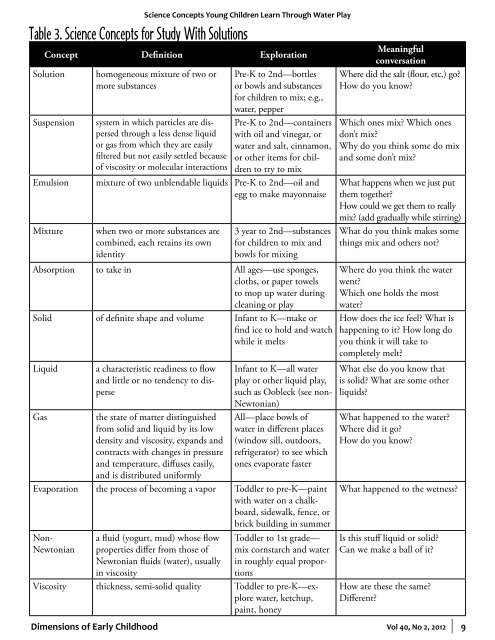Water Play - Southern Early Childhood Association
Water Play - Southern Early Childhood Association
Water Play - Southern Early Childhood Association
You also want an ePaper? Increase the reach of your titles
YUMPU automatically turns print PDFs into web optimized ePapers that Google loves.
Science Concepts Young Children Learn Through <strong>Water</strong> <strong>Play</strong><br />
Table 3. Science Concepts for Study With Solutions<br />
Concept Definition Exploration<br />
Solution<br />
Suspension<br />
Emulsion<br />
Mixture<br />
homogeneous mixture of two or<br />
more substances<br />
system in which particles are dispersed<br />
through a less dense liquid<br />
or gas from which they are easily<br />
filtered but not easily settled because<br />
of viscosity or molecular interactions<br />
Pre-K to 2nd—bottles<br />
or bowls and substances<br />
for children to mix; e.g.,<br />
water, pepper<br />
Pre-K to 2nd—containers<br />
with oil and vinegar, or<br />
water and salt, cinnamon,<br />
or other items for children<br />
to try to mix<br />
mixture of two unblendable liquids Pre-K to 2nd—oil and<br />
egg to make mayonnaise<br />
when two or more substances are<br />
combined, each retains its own<br />
identity<br />
3 year to 2nd—substances<br />
for children to mix and<br />
bowls for mixing<br />
Absorption to take in All ages—use sponges,<br />
cloths, or paper towels<br />
to mop up water during<br />
cleaning or play<br />
Solid of definite shape and volume Infant to K—make or<br />
find ice to hold and watch<br />
while it melts<br />
Liquid<br />
Gas<br />
a characteristic readiness to flow<br />
and little or no tendency to disperse<br />
the state of matter distinguished<br />
from solid and liquid by its low<br />
density and viscosity, expands and<br />
contracts with changes in pressure<br />
and temperature, diffuses easily,<br />
and is distributed uniformly<br />
Infant to K—all water<br />
play or other liquid play,<br />
such as Oobleck (see non-<br />
Newtonian)<br />
All—place bowls of<br />
water in different places<br />
(window sill, outdoors,<br />
refrigerator) to see which<br />
ones evaporate faster<br />
Evaporation the process of becoming a vapor Toddler to pre-K—paint<br />
with water on a chalkboard,<br />
sidewalk, fence, or<br />
brick building in summer<br />
Non-<br />
Newtonian<br />
a fluid (yogurt, mud) whose flow<br />
properties differ from those of<br />
Newtonian fluids (water), usually<br />
in viscosity<br />
Toddler to 1st grade—<br />
mix cornstarch and water<br />
in roughly equal proportions<br />
Viscosity thickness, semi-solid quality Toddler to pre-K—explore<br />
water, ketchup,<br />
paint, honey<br />
Meaningful<br />
conversation<br />
Where did the salt (flour, etc.) go?<br />
How do you know?<br />
Which ones mix? Which ones<br />
don’t mix?<br />
Why do you think some do mix<br />
and some don’t mix?<br />
What happens when we just put<br />
them together?<br />
How could we get them to really<br />
mix? (add gradually while stirring)<br />
What do you think makes some<br />
things mix and others not?<br />
Where do you think the water<br />
went?<br />
Which one holds the most<br />
water?<br />
How does the ice feel? What is<br />
happening to it? How long do<br />
you think it will take to<br />
completely melt?<br />
What else do you know that<br />
is solid? What are some other<br />
liquids?<br />
What happened to the water?<br />
Where did it go?<br />
How do you know?<br />
What happened to the wetness?<br />
Is this stuff liquid or solid?<br />
Can we make a ball of it?<br />
How are these the same?<br />
Different?<br />
Dimensions of <strong>Early</strong> <strong>Childhood</strong> Vol 40, No 2, 2012 9
















